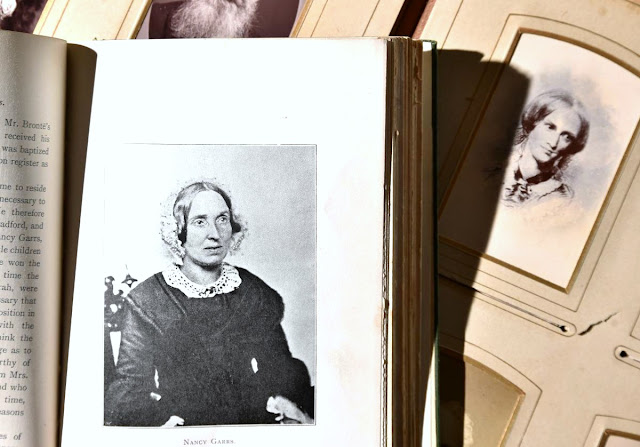NANCY De Garrs was quite a ‘celebrity’ in Bradford Workhouse
While other inmates sat on wooden benches, Nancy had her own armchair. There was much interest in the old lady who had been the Bronte family’s nanny, and she was visited by journalists keen to interview the last person to know the famous literary sisters.
Nancy loved to talk about her time with the Brontes. But with old age, and poverty, came a fear of ending up in a pauper's grave. When Nancy told the Pall Mall Gazette it was her last request to avoid such a fate, the London newspaper appealed for public donations so she could have a decent burial. It was taken up by other newspapers, including the New York Times. How much was raised isn’t clear. A 'typo' in a Manchester newspaper meant that some of the money was sent to Bedford workhouse, instead of Bradford...
One of 12 children of a Bradford shoemaker, Nancy is remembered for another reason too - she restored Patrick Bronte’s reputation at a time when history was re-written.
Nancy was at industrial school, learning housekeeping and childcare, when, aged 13, she was employed by Patrick as a nurse to his baby daughter, Charlotte, in 1816. When Nancy’s sister, Sarah, was later taken on too Nancy was promoted to cook and assistant housekeeper. The sisters lived with the Brontes at Thornton, moving with them to Haworth in 1820. “They must have been quite a sight - trudging up Haworth main street in a carriage, with half a dozen carts behind. Little did the onlookers know this family would make Haworth world famous,” says Stephen.
When the Brontes’ mother, Maria, died in 1821 her sister looked after the household, and Nancy and Sarah were no longer needed. But, says Stephen, Patrick thought so highly of them he gave them a substantial £10 each as a leaving present. In 1824 Nancy married John Wainwright and they had a daughter, Emily. John died in 1838 and Nancy later married Irishman John Malone, who worked at a wool warehouse in Cheapside, Bradford.
By 1857, when Elizabeth Gaskell’s biography The Life of Charlotte Bronte was published, Nancy had outlived the Bronte siblings. “Mrs Gaskell’s book made outlandish claims about Patrick; among them that he burned the children’s boots, cut up Maria’s dresses and fired pistols out of the Parsonage door. She also called Nancy and Sarah ‘wasteful servants’,” says Stephen. “Nancy was angry and went to see Patrick, who wrote a reference for the sisters, stating: ‘I can truly say that no master was ever blessed with two more careful and honest servants’. Nancy had it framed.”
Adds Stephen: “It seems Mrs Gaskell got her evidence from a village woman who’d been fired by Patrick. After meeting Nancy, Patrick’s friend, William Dearden, wrote a letter to the Bradford Observer defending him. Mrs Gaskell withdrew some statements. Nancy played a major part in restoring his reputation.”
When Nancy’s second husband died she fell into poverty and in 1884, aged 80 she left her Manningham home for the workhouse. It was then that Nancy parted company with treasured gifts from Patrick and his children, known as the ‘Bronte relics’. They included a roasting jack from the Parsonage, a little book from Charlotte to Nancy’s child, and what is thought to be a photograph of Charlotte on glass, which she showed to a local journalist.
“Nancy never tired of talking about her days with the Brontes and when she was offered £5 for a letter from Charlotte she wouldn’t part with it,” says Stephen.
So why did her Bronte relics end up with her nephew, John Hodgson Widdop, a Manchester Road draper. Did Nancy ask him to look after them? Did she sell them to him? Stephen’s research revealed that Widdop was bankrupt and served time in prison for obtaining goods by false pretences. A Bradford Daily Telegraph report in 1885 lists a “collection of Bronte curiosities” Widdop displayed at a bazaar in the city. He later sold three Bronte relics, including Patrick’s 1857 letter, to the Parsonage Museum.
The Charlotte photograph remains a mystery. Says Stephen: “Did it survive? Will it ever be discovered? It may have been an Ambrotype photograph ‘taken on glass’ after 1852. Or a Dagurreotype taken earlier.”
It was Widdop who dealt with the funds raised for Nancy’s burial. She was buried with his mother, (Nancy’s sister, Mary), and father - there was no headstone, but the Bradford Daily Telegraph reported that she arrived at the cemetery by hearse in a “black coffin with brass furnishings and two wreaths of flowers”.
Nancy’s obituary in the Keighley News on April 3, 1886 said: “All her means were gone and she accepted the workhouse as an asylum wherein to spend the remainder of her days.” Stephen is researching the whereabouts of Nancy’s daughter, Emily.
Victorian hierarchy continued in death at Undercliffe Cemetery. There are 124,000 burials there, in plots ranging from ornate headstones to paupers’ graves - one containing 124 people. Now Nancy is one of the “Bradford Worthies” whose stories, researched by volunteers, are told in the cemetery. By scanning their phones on a series of QR codes around the site, visitors can learn more about people buried there.
As well as civic and industrial leaders we remember people like Nancy who did good things but, as ordinary working people, were erased from history," says Stephen.
Adds Allan: "Like many interesting characters buried here, Nancy was hidden in undergrowth for a long time. We have an important part of the Bronte story right here."
Nancy's story will be included in a "Bradford Worthies" tour at Undercliffe Cemetery in September. Also that month, Bradford actress and writer Irene Lofthouse will be talking about Nancy's life in character.
* For more about the fundraising appeal call Undercliffe Cemetery on (01274) 642276.




Great that Nancy gets a headstone!It's thanks to the De Garrs sisters we know a good deal about the Bronte younger years
BeantwoordenVerwijderen